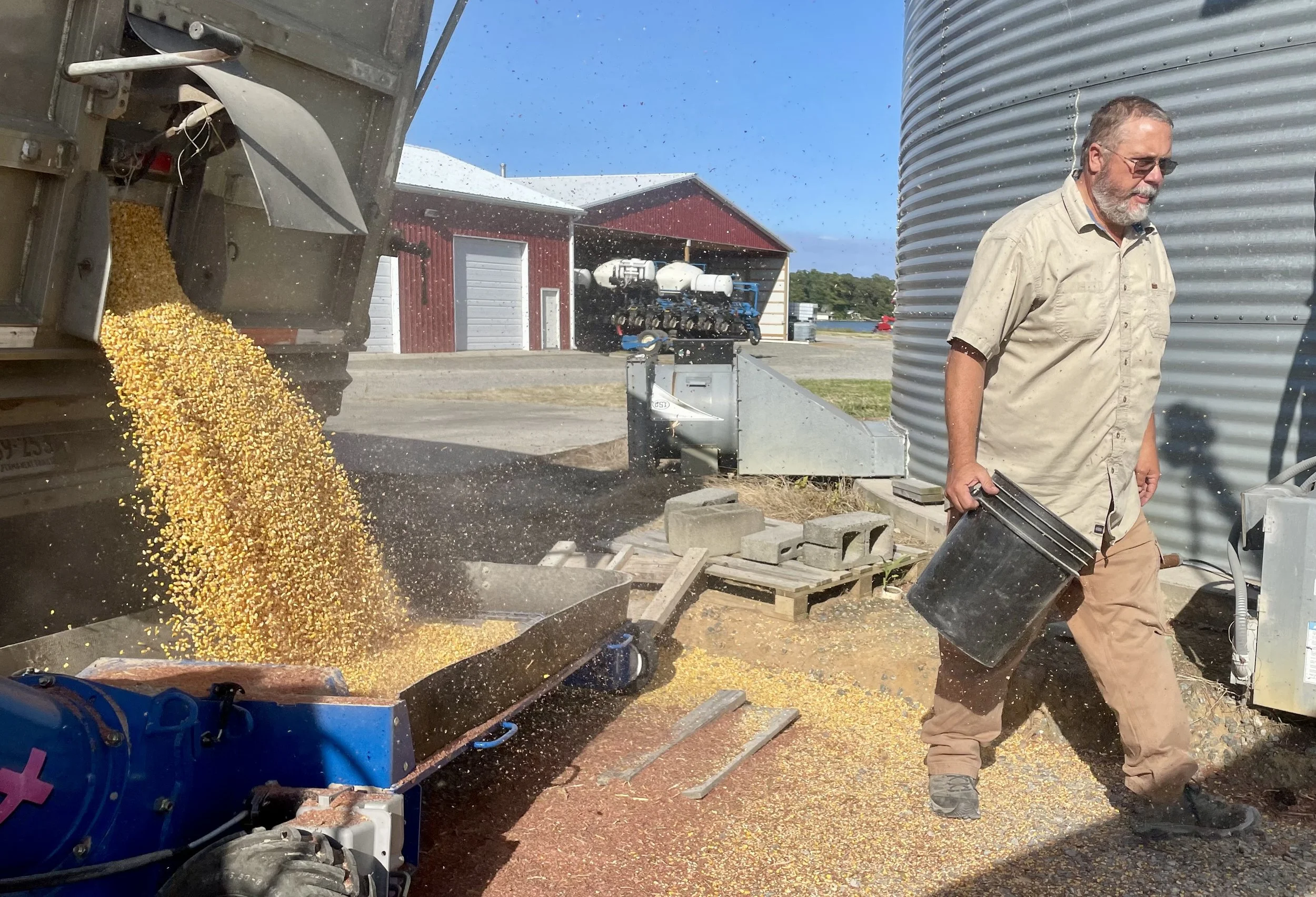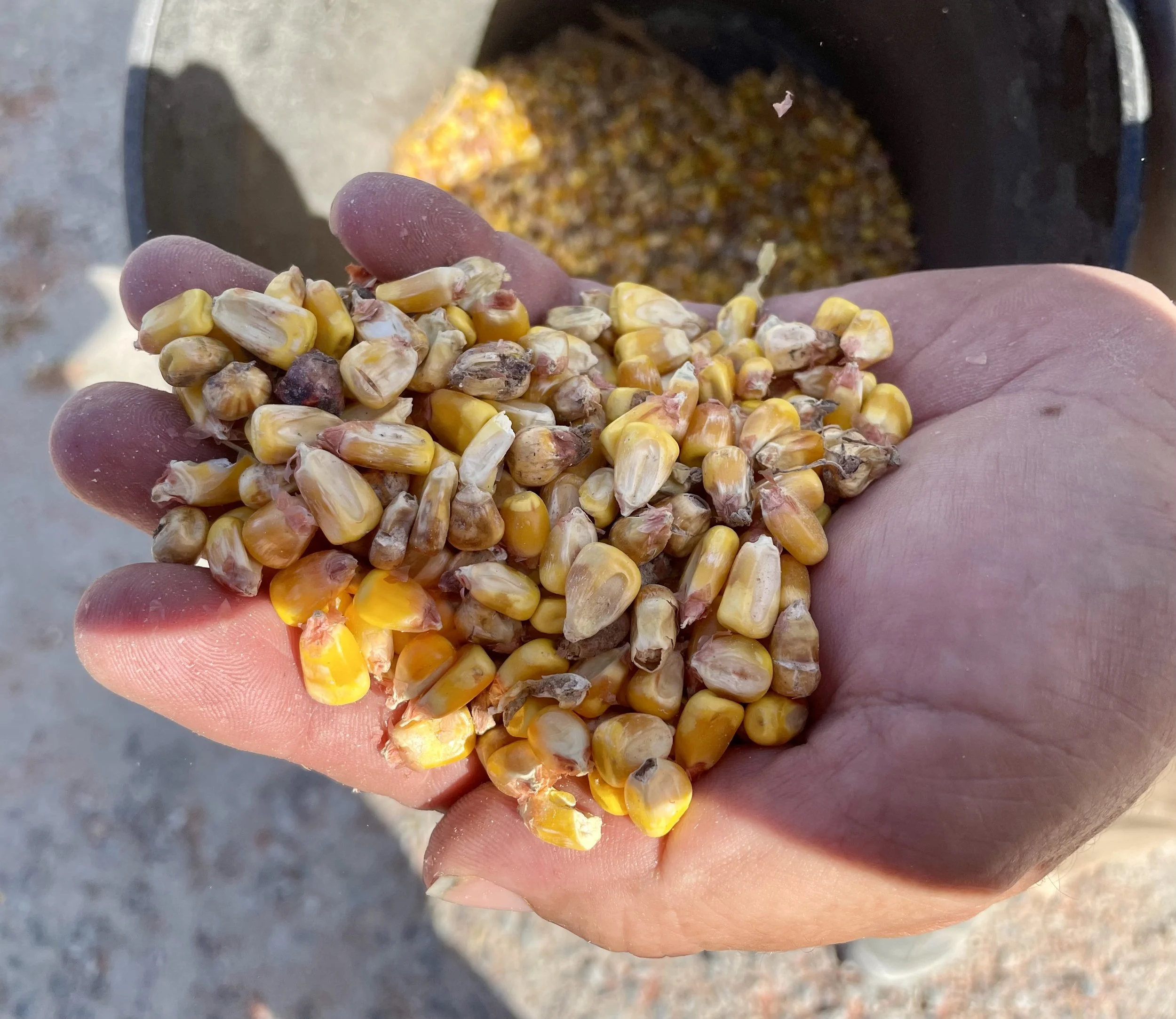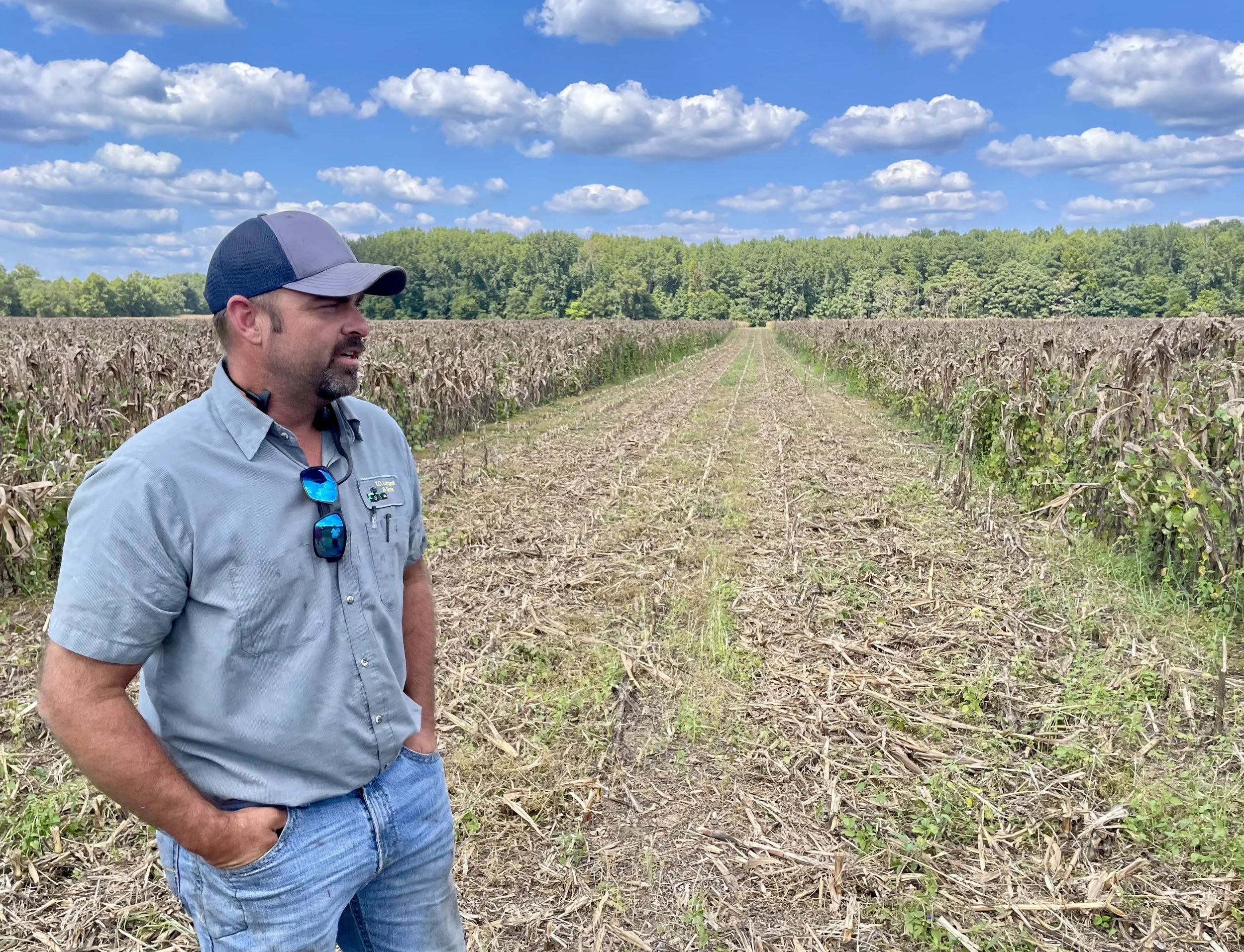Michael Downing, owner of Bleak House Farm in Lottsburg, Va., unloads a truck of grain into one of his bins on Sept. 6. Corn from his fields has already been rejected at two elevators in the state, so he’s decided to store what’s left on his farm until he can figure out what, if anything, to do with it. “Farming’s not fun this year,” he said. | Photos by Jonathan Cribbs
Virginia corn growers facing ‘catastrophe’
Downing holds half-rotted corn harvested from one of his fields on Sept. 6. He said he expects to lose about three quarters of his harvest this year due to low yields, crop damage, drought and aflatoxins.
Following extreme summer drought, farmers experience one of state’s worst harvests in recorded history
By JONATHAN CRIBBS
Sept. 17, 2024
LOTTSBURG, Va. — As the sun began to set on another long, dreadful day of harvesting at Bleak House Farm on Sept. 6, Michael Downing was patiently waiting for a busy crop adjuster to arrive so he could test samples of his corn, much of it likely damaged, toxic or both.
He had spent most of the day loading corn into bins instead of trucking it to buyers almost certain to reject it. More than two hours away in Waverly, one of his truck drivers had been waiting in line for nearly 12 hours at a rare elevator accepting low-quality grain from the state’s drought-devastated corn crop.
Factoring in anemic yields, crop damage and toxins, Downing estimated that he might only sell a quarter of what he planted. The harvest has been “chaos”, he said.
“Growers 20 years older than me have never seen this,” said Downing, 48. “They’re just baffled.”
Farmers are finally coming face to face with the disastrous results of an extreme drought in June that stunted corn crops and left them susceptible to pathogens and other issues that could create heavy losses in Virginia and region-wide this year. Nearly 60 percent of the state’s corn crop was rated poor or very poor in the USDA’s crop progress report on Sept. 9.
Farmers said they’re facing a unique constellation of challenges. Many growers have experienced low yields or prices, poor weather, extreme crop damage or high input costs across theri, but rarely, if ever, have they combined in the same year. Prices at elevators across the state last week ranged between $4 and $5 per bushel.
“Even if this year was a great year as far as yield… they would have to average over 200 bushels an acre just to see some kind of profit,” said Taylor Hubbard, director of government affairs and membership at the Virginia Grain Producers Association.
The coastal Tidewater region of Virginia received just 1.93 inches of rain in June — the fifth-worst total for that month on record, according to the National Oceanic and Atmospheric Administration. In other parts of the state, it was even worse. Northern Virginia received just 1.05 inches — its worst on record.
Wayne Burch, an adjuster who works across the state for Rain and Hail, a popular crop insurer, said although there’s good corn in spots, he’s seen many fields averaging just 50 bushels an acre. Just one ear out of three might have decent corn on it, leading growers to question whether it’s worth harvesting at all.
Kevin Norman, 43, stood with Burch in one of his desiccated fields in Stevensville, Va., on Sept. 11 as Burch plucked the lone cob from a brittle stalk. It was rotted, moldy and misshapen.
“That’s pitiful,” Norman said.
Due to the drought, the corn ears stood at nearly 90 degrees instead of tipping over, he said. When rain finally came in July, the moisture simply pooled inside the ears, and the crop was already susceptible to mold and smut as it was weakened by the drought.
He expects to destroy much of his 2,000-acre crop this year, but he was reluctant to run his tractors over it in dry weather, fearful that he might spark a fire. If he’s lucky, he said he might get 250 acres of salable corn from his fields — a 25-percent crop for T.O. Longest Farms.
“I really don’t know what it means right now,” he said. “I wish I knew more. Here it is, Sept. 11, and normally we’re in a rhythm, just constantly harvesting, getting out in the field, doing all of our rotations and whatnot, and now we’re kind of skipping around, finding rotten grain, sprouted grain, no grain. We are definitely out of our rhythm.”
But corn that looks good isn’t necessarily good either. The drought spawned a secondary issue bedeviling harvesters this year: aflatoxin, naturally occurring and produced by a fungus identified by gray-green or yellow-green mold on kernels.
Even at low levels, aflatoxin is poisonous to warm-blooded animals, and it can break out due to plant stress from drought, heat or insect damage. In corn, the FDA considers aflatoxin safe for animal feed so long as it remains less than 20 parts per billion. Elevators across the state are testing more for it this year than usual with varying thresholds for rejection. Burch showed a reporter two recent corn samples he’d collected. One bag was filled with unsalable, moldy kernels. Another was filled with bright, healthy-looking yellow kernels that ultimately tested for aflatoxin at nearly 190 parts per billion. While sampling a field last week, Burch said he noticed cobs that had been pulled down by wildlife. They were left uneaten on the ground. Unsurprisingly, he said, the crop tested positive.
Aflatoxin has been a huge problem for Downing. After pulling together a truckload from a harvest averaging roughly 70 bushels an acre with up to 25 percent lost to crop damage, he found himself rejected at a Perdue elevator in Tappahannock on Aug. 30. Aflatoxin in the load was measured at 106 parts per billion. Rain and Hail, his insurer, required him to get it rejected a second time to file a claim. (Burch is also his adjuster.)
He took another load to Perdue the next week. It was accepted, only to be rejected several hours later for aflatoxin. He’s sympathetic to the company’s predicament.
“They’re taking higher numbers (of aflatoxin) than they ever have. They’re not sure what to do,” he said.
Perdue warmed 2,300 growers in North Carolina and Virginia who have delivered to their elevators over the last year about aflatoxin breakouts due to the drought, said Tom Ryan, a company spokesperson. They were informed that loads exceeding FDA guidelines would be rejected.
On Sept. 4, Chris Cullins, manager of Wicomico Grain Elevator in St. Mary’s County, Md., was scheduled to head to a Perdue facility in Virginia to receive training about aflatoxin before Maryland’s harvest began in earnest.
“I’ve seen some corn come through here already this year that looks like some really nice looking corn,” he said. “It’s worse south of us.”
As he stood next to a giant auger slowly moving a truckload of dusty corn into one of his bins, Downing was waiting for lab work from Rain and Hail that would likely determine the fate of his crop. Perdue in Tappahannock is his buyer of choice, and the next closest is 100 miles away — too far, potentially, for such a devastated crop. He noted that he’s never spent more time with Burch in his life.
“I’ve been through droughts before,” he said. “I’ve needed (my insurer) before, but never where you have damaged grain, aflatoxin, poor yields. You’ve got three things hitting you. It’s just hard to know how to proceed.”
Norman said he was already looking ahead to next year.
“It’s a corn catastrophe. It can’t get any worse in my book,” he said. “If a hurricane came right now and blew it on the ground, it wouldn’t matter.”
(This article was published in the Delmarva Farmer in Easton, Md.)
Kevin Norman, 48, a grain farmer in Stevensville, Va., stands in a desiccated cornfield that produced virtually nothing this year due to drought and disease. He plans to destroy the crop, but he’s waiting for damper weather, fearful that his tractor could spark a fire on the dry field.


